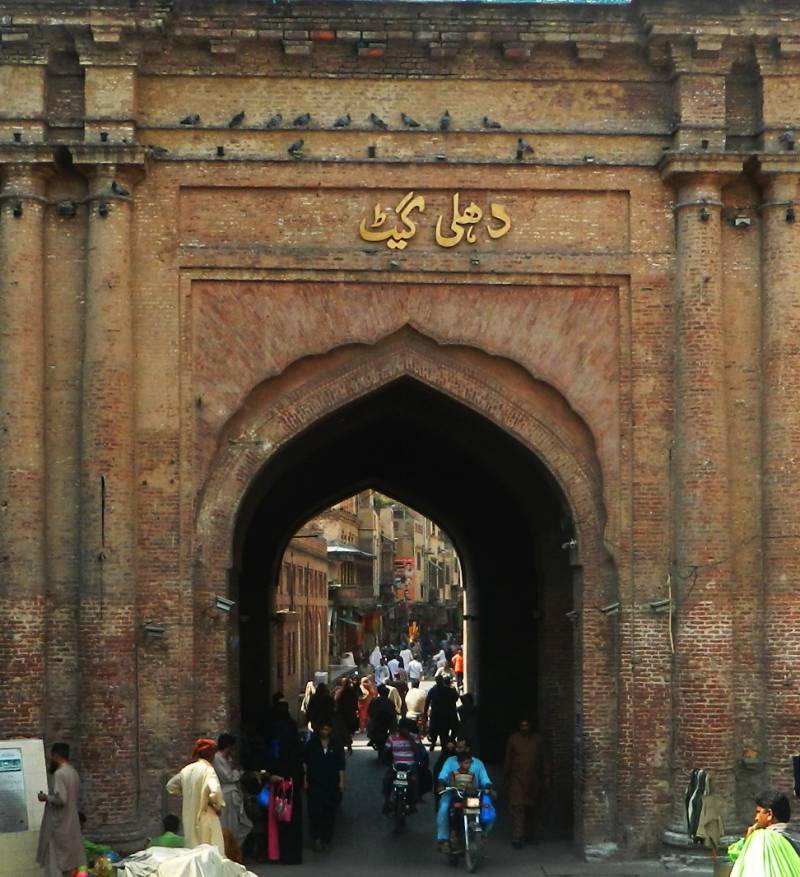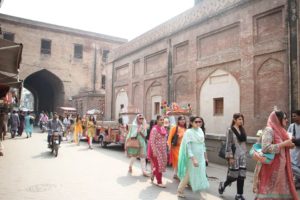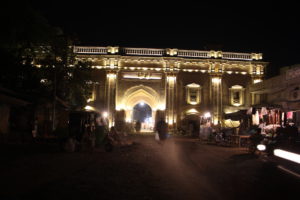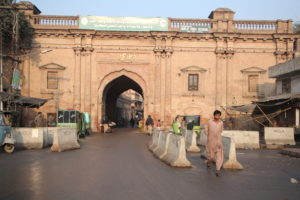
I always thought that why the city has gates? And thus I started my journey to get more and more into this subject. Through the available literature and research I got to know that the city gates connected with walls were traditionally built to provide a point of controlled access to in and out from a city for people, vehicles, goods and animals, and this concept was ages old.
You will be surprised to read that the city gates were also used for defense, security, health, trade, taxation, and representation, and were equally staffed by military or municipal authorities. Those were the times when there were no means of communication like we have now. And thus, the city gates were the point of communication and dissemination of information for the masses. These city gates were frequently used to announce public information such as tax and toll schedules, standards of local measures, and messages by the emperors or the rulers.
It is said that the public was gathered at any one of the gates of the city and announcements were made there by the courtiers and guards of the fort or the castle. The gates of a city were heavily fortified, ornamented with shields, sculpture or inscriptions, or used as a location for warning or intimidation. You would be shocked to read that many a times, as a lesson for others, the heads of the beheaded criminals, rebels or enemies were hanged outside the gates for the public to know what their fate could be if they got involved in conspiracy against the throne. What a horrifying sight it must have been.
So these gates were meant for several purposes and now who knows what’s hidden in the foundations, mortar, plaster and bricks of the gates which exist till now all around the world.
We are lucky to have some walled cities with gates in Pakistan and the most popular walled city is in Lahore which is called the cultural capital of the country. There was a time when the walled city of Lahore was an ignored and neglected side of Lahore. People had to think several times before taking a route towards it because of the traffic congestion and above all no one knew what gems were hidden inside its great walls with giant gates. Walled city always fascinated me because of the gates – huge gates aging to old times and hiding countless stories in their thick mortared walls and bricks.
So coming to one of the giant and strong structured gates of the walled city of Lahore, let me tell you a little about Delhi Gate. This gate is one of the thirteen gates of Lahore which were built by the third Mughal Emperor Akbar in 1600s. These thirteen gates provided access to the city of Lahore which was once enclosed within a thirty feet high fortified wall, built by the same Mughal emperor. The wall does not exist anymore, but few of the gates can still be seen as some have been razzed to ground with the passage of time. All the gates of the Walled City of Lahore were demolished during the British era. A circular road and circular garden, which still exist today, were built after the grand demolition. Other facts affirm that the bricks of the wall were used in constructing the Railway Station of Lahore by Mian Sultan, a contractor of British era. Somehow, only the gates were reconstructed in early 1900’s by the British.
If you want to reach Delhi gate, simply take the route to Railway Station Lahore and crossing the old Do Moria Bridge and taking a left turn you will get to see a signage of Delhi Gate and as you go straight you will see this huge structure on your right side.
To me this outstanding gate is the gateway to the city of explored and unexplored wonders - a city which has an aura found nowhere in the world.
You must be thinking that why was it named as Delhi Gate? Well it was named so because it faces towards Delhi, which was the capital of the Mughal Empire and at one time in history this gate remained the main entrance to the city of Lahore.
Also, the Mughals and other rulers used this route to enter the city and go to the grand Royal Fort and the passage which connects this gate with Lahore fort is called the ‘Royal Trail’. The same gate was used by the commoners and all the travelers. Interesting fact is that this gate once had wooden doors like Akbari gate of fort, but with the passage of time the doors vanished. There were guards standing outside the wooden gates, the gates were opened at sunrise and closed at sunset…no one was allowed to enter the city after sunset without the permission of the head guards. Can you imagine a city closing at sunset now? And yes today if you go to the walled city, it is a city that never sleeps.
Delhi Gate is a bystander of various ups and downs of the city. For the locals, it was a pile was bricks and mortar, a very normal structure and only important for those whose children were studying in the upper storey of the gate, which was turned into a school.

The structure of the gate was changed during the British rule in subcontinent. The city gates were pulled down by the British in 1800s and a circular road and a garden were added which we still see today. Later in early 1900s the gates were rebuilt in the colonial architecture style mixed with Mughal architecture. So this is now a different gate from what Akbar the Great had built.
Many of the historians and I believe that the location of the gate was shifted when it was rebuilt. It is evident from the Mughal architecture that Mughals were particular in symmetry and if we follow the Mughal architecture style the grand Mosque of Wazir Khan would have been visible from the gate but now it’s not like that. With several changes in the cityscape during the floods redesigning the city by the British the places shifted and so did the gate.

The structure of this gate is most interesting and unique if compared with other gates of the city. It is a double storeyed gate with almost twelve rooms which house the school at present. The best thing I like about this gate is the staircase that leads you to the rooftop of the gate from where you can have a panoramic view of the high rise rooftops and the city. Once the Minars of Wazir Khan Mosque were visible from the rooftop of Delhi Gate but later with the building of high rise buildings the scene had been lost. The stair case has been constructed at a very different angle probably at 90 degree angle in order to protect the building from sudden attacks. While going up the stairs, one loses the momentum and speed to climb and this depicts the techniques of defense in those days by the clever architects.
There are rooms on the ground floor of the gate which is the entrance into the Delhi Gate bazaar. There are three spacious rooms on both sides. Three have been converted into the tourism information center by the Walled City of Lahore Authority, a Government body which looks after the management of the city and other three house an attractive crafts center. These rooms were used by the chobdars in Mughal era, magistrate and police in later eras. For some time after 1947, the rooms served as dispensary and health centers for the local community.
Once there were several encroachments inside the entrance of this gate and street vendors had set up their stalls blocking the rooms and view of the city. In 2014, the encroachments were removed by the Walled City of Lahore Authority and the entire structure of the gate was restored and now, one can move easily in the gate. After the restoration of the Royal Trail which leads from Delhi Gate to Masti Gate (Lahore Fort) the trail is banned for freight traffic during the day so that tourists can move around easily. It is also illuminated at night for the tourists to have a real treat.

The trail leading from this gate to Lahore Fort possesses world class monuments like Shahi Hammam, Wazir Khan Masjid, Sonehri Masjid, Janam Astha Guru Arjun Ram, Mariam Zamani Mosque, Haveli of Asif Jah and then finally the citadel of Pakistan, Lahore Fort. Most of the popular markets are also located here which include Akbari Mandi, Kasera Bazaar, Waan Market, Pakistan and Azam Cloth Market and Kashmiri Bazar.
I suggest that all of Lahoris must visit this site as there are guided tours organized by the walled city of Lahore authority for free. I am sure that once you get to this giant gate you will be awe stunned by the scenes and beauty of the place.
You will be surprised to read that the city gates were also used for defense, security, health, trade, taxation, and representation, and were equally staffed by military or municipal authorities. Those were the times when there were no means of communication like we have now. And thus, the city gates were the point of communication and dissemination of information for the masses. These city gates were frequently used to announce public information such as tax and toll schedules, standards of local measures, and messages by the emperors or the rulers.
It is said that the public was gathered at any one of the gates of the city and announcements were made there by the courtiers and guards of the fort or the castle. The gates of a city were heavily fortified, ornamented with shields, sculpture or inscriptions, or used as a location for warning or intimidation. You would be shocked to read that many a times, as a lesson for others, the heads of the beheaded criminals, rebels or enemies were hanged outside the gates for the public to know what their fate could be if they got involved in conspiracy against the throne. What a horrifying sight it must have been.
So these gates were meant for several purposes and now who knows what’s hidden in the foundations, mortar, plaster and bricks of the gates which exist till now all around the world.
We are lucky to have some walled cities with gates in Pakistan and the most popular walled city is in Lahore which is called the cultural capital of the country. There was a time when the walled city of Lahore was an ignored and neglected side of Lahore. People had to think several times before taking a route towards it because of the traffic congestion and above all no one knew what gems were hidden inside its great walls with giant gates. Walled city always fascinated me because of the gates – huge gates aging to old times and hiding countless stories in their thick mortared walls and bricks.
So coming to one of the giant and strong structured gates of the walled city of Lahore, let me tell you a little about Delhi Gate. This gate is one of the thirteen gates of Lahore which were built by the third Mughal Emperor Akbar in 1600s. These thirteen gates provided access to the city of Lahore which was once enclosed within a thirty feet high fortified wall, built by the same Mughal emperor. The wall does not exist anymore, but few of the gates can still be seen as some have been razzed to ground with the passage of time. All the gates of the Walled City of Lahore were demolished during the British era. A circular road and circular garden, which still exist today, were built after the grand demolition. Other facts affirm that the bricks of the wall were used in constructing the Railway Station of Lahore by Mian Sultan, a contractor of British era. Somehow, only the gates were reconstructed in early 1900’s by the British.
If you want to reach Delhi gate, simply take the route to Railway Station Lahore and crossing the old Do Moria Bridge and taking a left turn you will get to see a signage of Delhi Gate and as you go straight you will see this huge structure on your right side.
To me this outstanding gate is the gateway to the city of explored and unexplored wonders - a city which has an aura found nowhere in the world.
You must be thinking that why was it named as Delhi Gate? Well it was named so because it faces towards Delhi, which was the capital of the Mughal Empire and at one time in history this gate remained the main entrance to the city of Lahore.
Also, the Mughals and other rulers used this route to enter the city and go to the grand Royal Fort and the passage which connects this gate with Lahore fort is called the ‘Royal Trail’. The same gate was used by the commoners and all the travelers. Interesting fact is that this gate once had wooden doors like Akbari gate of fort, but with the passage of time the doors vanished. There were guards standing outside the wooden gates, the gates were opened at sunrise and closed at sunset…no one was allowed to enter the city after sunset without the permission of the head guards. Can you imagine a city closing at sunset now? And yes today if you go to the walled city, it is a city that never sleeps.
Delhi Gate witnessed seasons of harmony, tranquility and turmoil in different times of history and especially when the rules changed.
During the Mughal era this gate was the most important gate and enjoyed the status of the reception gate to the Royal City with the soldiers and guards welcoming people. When the British rule took over it was turned into a court of a magistrate, rooms were the small jails, and local police station. After partition a girl’s school was housed inside the gate building which is still there. The recent governments have tried to relocate the school but all efforts failed. The locals of the area also use the upper storey of the gate for marriages and religious ceremonies. I wish the gate could be turned into a museum or a cultural center! The rooms on the ground floor were used by the health department and local dispensary was set up there while in other rooms the office of Union Council of that area was set up…so that gate had lost all its value, worth and historic importance.
Delhi Gate is a bystander of various ups and downs of the city. For the locals, it was a pile was bricks and mortar, a very normal structure and only important for those whose children were studying in the upper storey of the gate, which was turned into a school.

The structure of the gate was changed during the British rule in subcontinent. The city gates were pulled down by the British in 1800s and a circular road and a garden were added which we still see today. Later in early 1900s the gates were rebuilt in the colonial architecture style mixed with Mughal architecture. So this is now a different gate from what Akbar the Great had built.
Many of the historians and I believe that the location of the gate was shifted when it was rebuilt. It is evident from the Mughal architecture that Mughals were particular in symmetry and if we follow the Mughal architecture style the grand Mosque of Wazir Khan would have been visible from the gate but now it’s not like that. With several changes in the cityscape during the floods redesigning the city by the British the places shifted and so did the gate.

The structure of this gate is most interesting and unique if compared with other gates of the city. It is a double storeyed gate with almost twelve rooms which house the school at present. The best thing I like about this gate is the staircase that leads you to the rooftop of the gate from where you can have a panoramic view of the high rise rooftops and the city. Once the Minars of Wazir Khan Mosque were visible from the rooftop of Delhi Gate but later with the building of high rise buildings the scene had been lost. The stair case has been constructed at a very different angle probably at 90 degree angle in order to protect the building from sudden attacks. While going up the stairs, one loses the momentum and speed to climb and this depicts the techniques of defense in those days by the clever architects.
There are rooms on the ground floor of the gate which is the entrance into the Delhi Gate bazaar. There are three spacious rooms on both sides. Three have been converted into the tourism information center by the Walled City of Lahore Authority, a Government body which looks after the management of the city and other three house an attractive crafts center. These rooms were used by the chobdars in Mughal era, magistrate and police in later eras. For some time after 1947, the rooms served as dispensary and health centers for the local community.
Once there were several encroachments inside the entrance of this gate and street vendors had set up their stalls blocking the rooms and view of the city. In 2014, the encroachments were removed by the Walled City of Lahore Authority and the entire structure of the gate was restored and now, one can move easily in the gate. After the restoration of the Royal Trail which leads from Delhi Gate to Masti Gate (Lahore Fort) the trail is banned for freight traffic during the day so that tourists can move around easily. It is also illuminated at night for the tourists to have a real treat.

The trail leading from this gate to Lahore Fort possesses world class monuments like Shahi Hammam, Wazir Khan Masjid, Sonehri Masjid, Janam Astha Guru Arjun Ram, Mariam Zamani Mosque, Haveli of Asif Jah and then finally the citadel of Pakistan, Lahore Fort. Most of the popular markets are also located here which include Akbari Mandi, Kasera Bazaar, Waan Market, Pakistan and Azam Cloth Market and Kashmiri Bazar.
I suggest that all of Lahoris must visit this site as there are guided tours organized by the walled city of Lahore authority for free. I am sure that once you get to this giant gate you will be awe stunned by the scenes and beauty of the place.
